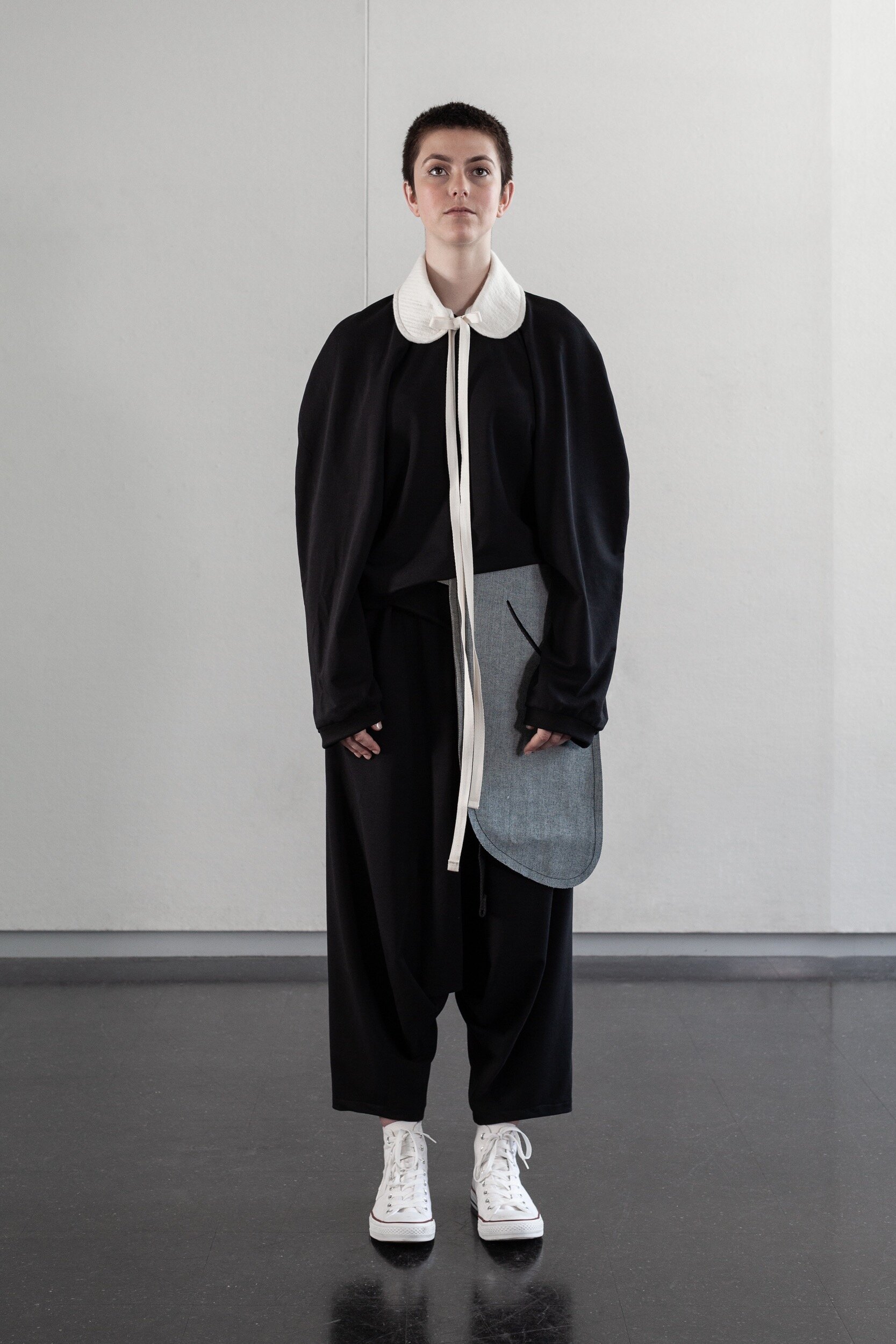An exploration of the ambiguity and significance of everyday affordable sustainable clothing.
Leica Johnson
An exploration of the ambiguity and significance of everyday affordable sustainable clothing.
Leica Johnson
New Zealand / Auckland University of Technology
Individuals ‘experiencing poverty often find it difficult to partake in contemporary consumption behaviours,’ consequently budget consumers are often left out of the sustainable fashion conversation.(1) The fast-fashion consumer has been identified as the least likely to adopt progressive, sustainable ways of consuming clothes.(2) By placing my attention beyond the object (a physical garment) I can work to add value to the way a garment is framed by establishing new value (purpose and experiences) of clothing for consumers of fast fashion thereby renewing and redefining what sustainable fashion is and could be. The result is the rematerialisation and reimagining of budget clothing, a new form of value creation via the pioneering of cultural expression.
The design and making of a socially equitable clothing collection questions the inequalities related to the unaffordability of sustainable fashion and challenges the stereotypes often associated with consumers of budget clothing. Beyond the object, clothes can confirm a person’s social status (due to their known affordability) or somehow work to represent a remembering of culture and community and by doing so establish new purpose and experiences of clothes. As a response to the realities of deindustrialisation, ongoing austerity and the associated impacts of poverty, my interest lies in the space between self-expression, and at the same time, belonging.
Acting as a counter to overconsumption and the current unsustainable impacts of the fashion industry on our environment, Utility rationing supports the aim of reducing the consumption of fashion in a contemporary context.(3) Historical research of social design reveals that WWII British Utility Scheme austerity measures restricted the amount of cloth and trims used in a particular type of garment; unnecessary decorations like embroidery and lace were banned. Designers were tasked to simplify the design of every piece of clothing by employing a limited number of seams per garment type and reducing unnecessary details like pockets or pleats. A low-tech, labour-intensive process that has hardly changed in the last one hundred years, the production and manufacture of clothing is currently driven by cost and price. By adopting and defining my own set of austerity measures I designed for limitations thereby reducing the make cost of clothing. Led by austerity derived constraints that reduced seams, eliminated trims and informed the type of fabrications used, the stripping back of trims and details coalesced to inform and define the aesthetics of the clothes. Setting the scope and boundaries of design practice, in lieu of detail, attention was placed on form whilst interchangeable durable accessories added practical value to the rationed garments. The action of repurposing and co-opting both new and used household goods and adaptively re-using them to make new ones, informed the type of fabrics the clothing collection was made from.
This body of work, an interchangeable affordable sustainable clothing collection, is an exploration of the ambiguity and significance of everyday affordable budget clothing and the associated negative impacts of social class positioning and stigma that can arise from this.
Footnotes
(1) T Shildrick and J Rucell, Joseph Rowntree Foundation, “Sociological Perspectives on Poverty: A review of sociological theories on the causes of poverty”, June 4, 2015, https://www.jrf.org.uk/report/sociological-perspectives-poverty
(2) W Gwozdz and K Nielsen, Field Report: Consumer Survey, A Mistra Future Fashion Report, 2019, accessed June, 2018.
(3) In 2018 it is estimated that 80 to 100 billion garments were manufactured for 8 billion people. In the same year, the United Kingdom sent 23 million items of clothes to landfill. London Sustainability Exchange, “What, Why, How and When”? The Textile Issue, 2018, accessed September 15, 2019 http://www.lsx.org.uk/blog/textile-issue-london-textile-forum-2018/
All photographs, Heyes Johnson, 2019.

Leica Johnson. 02. Expressive I. Item 13. Bondager dress, worn over Item 8. Loose fit pants. Accessorised with Item 5. Waistcoat with bum bag.

Leica Johnson. 01. Expressive. Item 9. Sweatshirt, worn with Item 11. Breeched sweatpants. Accessorised with Item 18. Collar, and Item 4. Big pocket bum bag.

Leica Johnson. 03. Occupation I. Item 16. Smock, worn over Item 12. Sweatpants.

Leica Johnson. 04. Hidden. Item 10. Hood, worn over Item 15. Smock, and Item 12. Sweatpants. Accessorised with Item 1. Mini pocket bum bag.

Leica Johnson. 05. Occupation Item15. Apron, worn over Item 17. Top, and Item 7. Front fold pants.

Leica Johnson. 06. Conforming. Item 17. Top, worn with Item 7. Front fold pants.

Leica Johnson. Medium shoulder pocket bag. Photographs of details, including: Laser cut pocket opening. Strap attachment & detail on back of bag. Strap fastening detail. Future sustaining elements were prefigured into fashion design approaches and practices to enable reuse or recycling and end of life recovery. Laser cutting was employed as a cost-effective means of making. Pocket bag straps are held in place by metal D-rings and cotton tape woven in New Zealand allowing for easy disassembly.

Leica Johnson. Fabrications Key showing key categories of textiles used to make affordable sustainable clothing for this body of work when based in New Zealand.
Bio: Leica Johnson
Leica is a lecturer, on the Bachelor of Fashion at the School of Art and Design, Auckland University of Technology, New Zealand.
The project includes excerpts from a thesis submitted to Auckland University of Technology in partial fulfilment of the requirements for the Degree of Master of Design: Leica Johnson, A remembering of culture and community: An exploration of the ambiguity and significance of everyday affordable sustainable clothing.
Thesis link: http://hdl.handle.net/10292/13367
